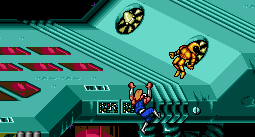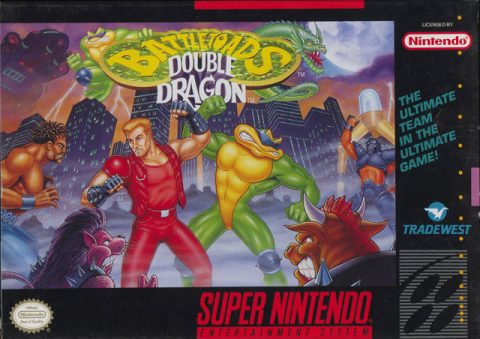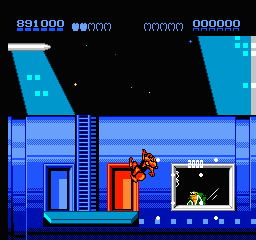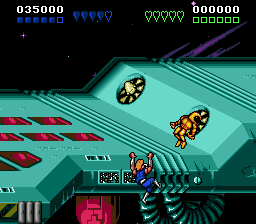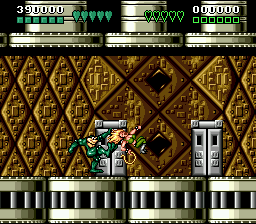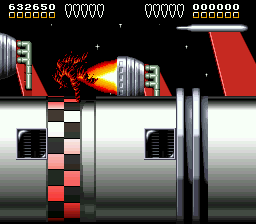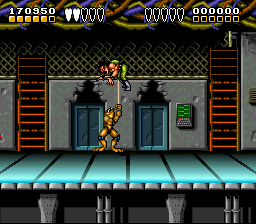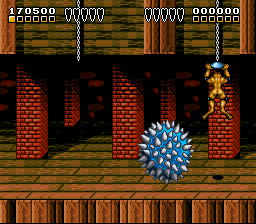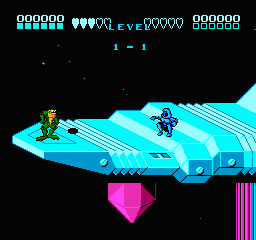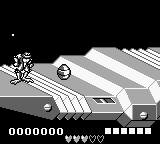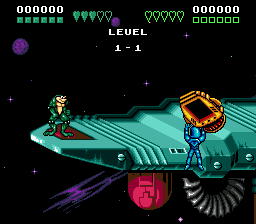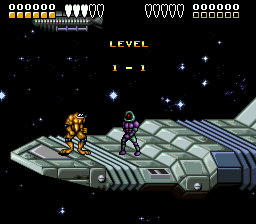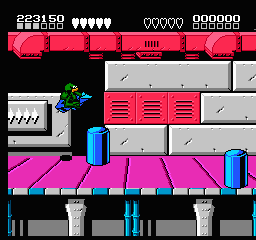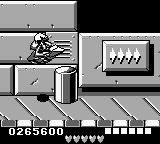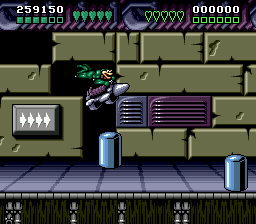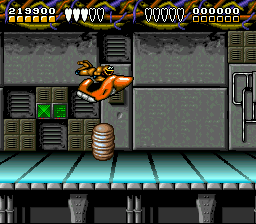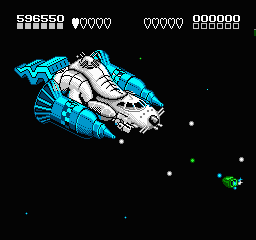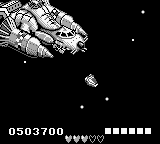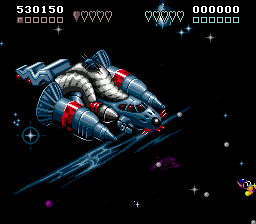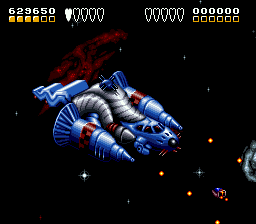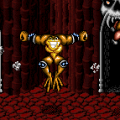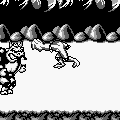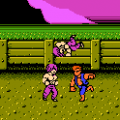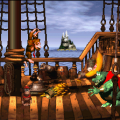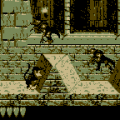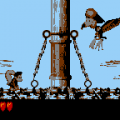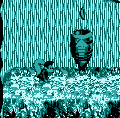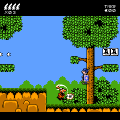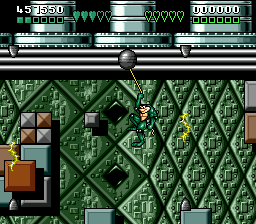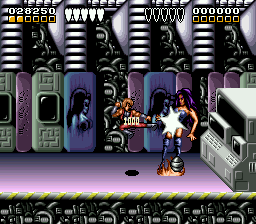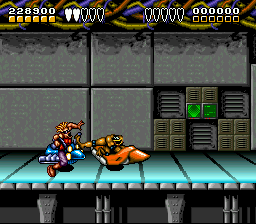- Battletoads
- Battletoads (Game Boy)
- Battletoads in Battlemaniacs
- Battletoads & Double Dragon
- Battletoads (Arcade)
- Battletoads (Misc)
In a rather unexpected move, Rare decided to make their next Battletoads title a crossover matchup with the original beat-em-up badasses from Double Dragon. Though Technos licensed use of their intellectual property, they had nothing else to do with this one: it’s basically a Battletoads game with Double Dragon characters along for the ride (possibly because Tradewest had published titles from both series outside Japan. Subsequently, the game was only published in the US and European territories). Subtitled “The Ultimate Team,” this game deals with the unlikely alliance of the Dark Queen and Shadow Boss (the main foe from the NES version of the original Double Dragon) in an attempt to conquer the earth with nothing less than a colossal rat-ship that explodes out of the moon.
Fittingly, the Battletoads team up with Billy and Jimmy Lee to put a stop to this. BT&DD is the first Battletoadsgame where all three Toads are playable characters, in addition to the Lee brothers, though the choice is largely inconsequential aside from the Dragons’ getting a jump kick. More importantly, this is the first game since the original to introduce entirely new level ideas and a fresh take on the series’ formula. Though some familiar elements do return, they’re implemented in a new way when they do, rather than appearing in a better-looking, slightly more complex coat of paint like in Battlemaniacs. For starters, combat takes the fore while platforming and vehicle gimmicks take a back-seat, so that challenge is now almost entirely derived from handling enemies rather than memorizing movement patterns or completing precision jumps. In fact, there’s only one level where you can even fall to your death, most of the time you’ll simply end up hanging over the side, useful for attacking enemies that approach in that manner though leaving you vulnerable from overhead attacks. Otherwise, the game engine is the same as the original but applied to the retooled mechanics: the only concession to Battlemaniacs is the choice of 2-player games A or B, where B will prevent you from harming your partner.
The general flow of the game has also been altered from previous entries in the series, taking after what the original Battletoads might have been without all of its gimmicks. Most of the levels are set up like the typical belt-scrolling beat-em-up: screen stops, you bash some guys, then continue onward. Notably, you now respawn in place whenever you lose a life, no matter what the circumstances. The rather long levels are divided up into two or three sub-areas, but you’ll only respawn at these checkpoints if you have to use a continue. Pick-ups now appear in item pods that litter the stages and can range from score boosts, 1-Ups, full health-refills, and occasionally temporary invincibility. You also can get extends at 100,000 point thresholds as well as in certain sequences by collecting or destroying a number of objects consecutively. You can even get them from juggling ravens in level 3, though this has been made much more difficult to do, to the point of being practically impossible in all but the SNES version.
If these much-needed alterations give one the impression that this game is somehow fair or more reasonably balanced than the original, guess again. While the first two stages are mostly devoid of the usual Battletoadsbullshit, the margin for error afterwards becomes quite small and though not having to restart at checkpoints as often is nice, your lives will really start to evaporate after that and few will manage to beat this game without cheating. And for all intents and purposes, the game is only five levels long! Play begins on the tail of the Dark Queen’s rat ship, where players have plenty of time to get a feel for combat against the new enemies and use the new hanging ability. Going inside the rat ship for level two isn’t much different, though we now get to see how the game features enemies and elements from both series at once. Walkers return here as do their useful appendages, there’s even a new Turbo Tunnel, mostly notable for being absurdly easy compared to its predecessors, though combat is now possible while riding one. Level three ramps the difficulty considerably while reducing combat to a single plane, heavily populating the level with dangerous machinery, and integrating new turbo cable challenges into its design. Level four, bizarrely, is a space shooter derived from Asteroids, where you pilot a pod avoiding mines and space debris before taking on the rat ship head on and picking it apart piece by piece. Though a lot of fun (you can spam shots as well as lock-on powerful missiles), there’s very little margin for error here. If you manage to make it this far, the rat ship will launch off an enormous rocket as its final strike against the Earth. Another 2-D level, you must run along the rocket’s length battling enemies and dodging flaming exhaust.
The final two levels are levels in name only: despite the couple of grunts populating them, they’re little more than brief corridors leading up to the final battles with Shadow Boss and the Dark Queen. Speaking of which, boss fights, which were curiously absent from Battlemaniacs, return with a vengeance for BT&DD. Every level ends with one, with level five having an additional three nearly identical fights against General Slaughter throughout the level. Previous Battletoads titles were lenient with these battles because, despite how cool their designs tend to be, boss fights in these games kind of suck. Nearly every one throughout the series has the same basic characteristics: they constantly go through a pattern of the same 1-2 attacks that usually take priority over yours, they take way too much damage to beat, and a lot of them can drain your full health meter if they catch you a certain way. Trying to carefully dodge their attacks and appropriately counterattack rarely leads to defeating them consistently; instead, the game expects you to find that one striking point that exploits their behavior and abuse it until they’re dead. BT&DD is the worst offender in this respect: many of the bosses initially feel like untouchable deities that you can’t lay a finger on and the fights are frustrating. Then you discover the exploit and they become mindlessly banal, with no happy middle ground in between. Some you can beat by repeatedly pivoting with your dash attack; others you can beat by simply standing in the right spot and mashing the attack button. There are exceptions to this (throughout the series even), but I’ve found most of them to be ill-designed and detracting from the overall experience.
Rare developed all four versions of Battletoads & Double Dragon, so the differences between the ports are mostly superficial. The NES version seems to have been the base model, but that doesn’t detract one bit from its impressiveness. Though the sprites and engine are based off the original Battletoads (with the Double Dragon sprites probably coming from their second NES game), Battletoads & Double Dragon pushes the hardware’s limitations, even allowing for some pseudo-3D effects in the Turbo Tunnel segment. There’s still some flickering and uninspired palette choices here and there, but the action is fast, smooth, and usually quite good-looking. Due to its late release in the console’s lifespan, it also commands higher re-sale values than any other Battletoads game. The Game Boy version is mostly identical, though there’s some expected losses in the downgrade. Like with Battletoads in Ragnarok’s World, the spritework is different, the animation is choppier, and the engine doesn’t feel quite right, particularly with hit detection. You also lose the 3-D effects, pick up items from capsules automatically, and have slightly smaller crowds of enemies to deal with, but otherwise the stage layouts, chiptunes, etc. are the same.
The SNES and Genesis versions are largely the same, featuring redrawn sprites and better visuals, though with slightly different (arguably better) music than the 8-bit versions. Each has its own unique look, leaving the preferential choice between them largely up to the individual. The SNES version has some different between-level dialog, unique cartoonier sprites, more colorful animation (particularly for the Ram’s Horns finisher and the bosses) and an absurd amount of Mode 7 effects in the intro, but the Genesis version sounds better and feels closer to the NES version than any of the others.
All four versions are about equally difficult, so however you masochists out there manage to get a hold of a copy will suffice.
Comparison Screenshots
